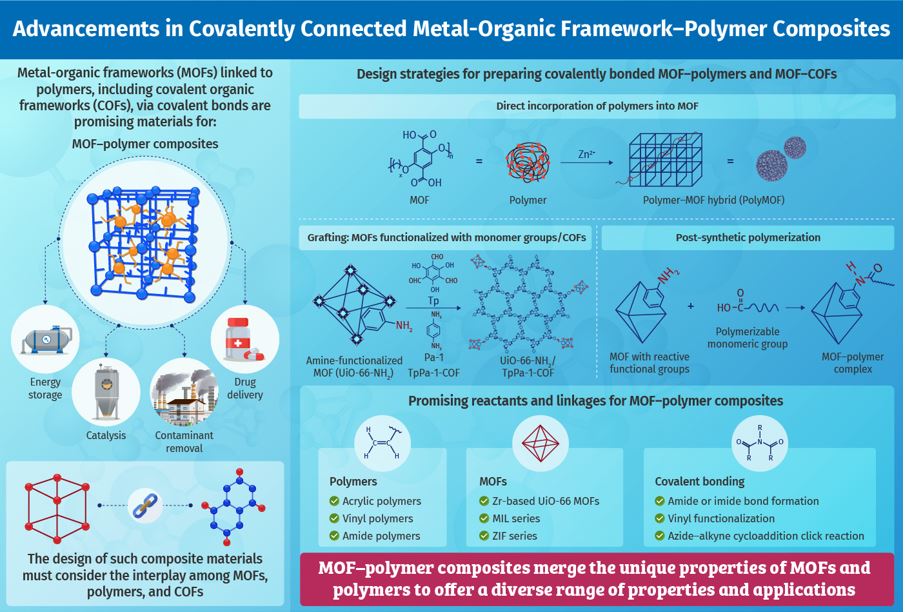
| Chungbuk National University Researchers Review Recent Advances in Metal-Organic work–Polymer Composites | |||||||
| Writer | 관리자 | ||||||
|---|---|---|---|---|---|---|---|

Image title: Advancements in covalently connected metal-organic framework (MOF)–polymer composites Image caption: Researchers review recent developments and strategies involved in preparing covalently connected MOFs and polymers, including MOF–covalent organic framework composites. Image credit: Min Kim from Chungbuk National University License type: Original Content Usage restrictions: Cannot be reused without permission
The integration of polymers through covalent bonds improves the stability of and adds functionality to metal-organic frameworks
Combining metal-organic frameworks with polymers or covalent organic frameworks through covalent bonds can substantially enhance their stability and functionality for real-world applications. In this context, researchers have recently reviewed various synthesis strategies, popular reactants, covalent bonds, polymer backbones, and applications of these hybrid materials, which have the potential to revolutionize fields like energy storage, fuel-cell vehicles, contaminant removal, and carbon capture. Metal-organic frameworks (MOFs) are three-dimensional crystalline structures consisting of metal ion nodes connected by organic ligands. These structures are highly sought after due to their porous nature and large surface area. Furthermore, as the choice and arrangement of specific metal ions and ligands can be customized to achieve desired properties and functions, MOFs find use in a wide range of applications, including energy storage, gas capture, catalysis of chemical reactions, and contaminant removal.
Despite their immense potential, MOFs face challenges due to inherent instability when exposed to heat, water, or physical stress. A promising solution that addresses these limitations involves creating hybrid materials by combining MOFs with polymers or covalent organic frameworks (COFs) through covalent bonds. These secondary materials enhance the stability and functionality of MOFs by leveraging their characteristics and their attachment to the MOFs. For instance, polymers introduce flexibility to the otherwise rigid MOFs, while porous COFs improve their porosity.
Now, in a review article published in the journal Chemical Society Reviews on 5 September 2023, a group of researchers from Chungbuk National University (CBNU) and Seoul National University in Korea, led by Professor Min Kim of the Department of Chemistry of CBNU, review the latest developments in this field. They discuss strategies for connecting MOFs to COFs and polymers through covalent bonds, along with the practical applications of the resulting hybrid MOF–organic network composite materials.
“In this article, we have distilled a critical chemical connection between two significant foundational materials. One of these materials is conventional soft polymers, while the other is relatively new, porous MOFs,” says Prof. Kim.
The researchers found that acrylic polymers are preferred for their compatibility with various functional groups, while vinyl polymers are valued for their versatility. Regarding MOFs, Zr-based UiO-66 (University of Oslo) MOFs and MIL (material from the Institute of Lavoisier) series were found to be widely used due to their stability under various synthesis conditions.
The techniques for synthesizing MOF–polymer hybrid structures include post-synthetic polymerization, where polymers are directly incorporated into the MOF structure via a chemical reaction, and post-synthetic modification, where pre-synthesized MOFs are combined with small organic molecules. Many approaches combine these methods to link MOFs with polymers using highly reactive click reactions like azide–alkyne cycloaddition. Other synthesis methods include hybridization strategies such as grafting, where the surface of MOFs is functionalized with monomer groups of polymers. In all these techniques, reaction conditions, MOF stability, and polymer properties were found to be critical for the success of the reaction and the functionality of resulting composite materials.
Another commonly used technique for linking MOFs to polymers involves functionalizing MOFs with amino groups and subsequently connecting them to polymers through amide (including imide) formation. The review also highlights an emerging approach involving the direct incorporation of polymers into crystalline MOF structures, resulting in polyMOFs. These materials offer the potential to create flexible MOFs with polymer properties, including ultrathin flexible membranes known as single-component MOF mixed matrix membranes.
"These methods underscore the efforts of research groups dedicated to enhancing MOF stability and functionality," points out Prof. Kim. “Porous MOFs hold the potential to be used in various industrial processes, such as capturing carbon dioxide or methane, as well as for hydrogen storage in fuel-cell vehicles, extending the operational lifespan of these applications. Furthermore, MOFs can also find applications in proton conductors in battery electrolytes for energy storage technology.”
As composite MOFs continue to evolve, they hold the promise of revolutionizing various industries!
Reference
About the institute
Chungbuk National University, located in Cheongju, South Korea, is a distinguished institution renowned for its commitment to academic excellence, research innovation, and community engagement. Founded in 1951, the university offers a wide spectrum of undergraduate, graduate, and doctoral programs spanning diverse fields and maintaining rigorous academic standards. It is a hub of cutting-edge research, with numerous research centers and institutes dedicated to technological advancements, healthcare, agriculture, and cultural studies.
About the author
Min Kim is a Professor of Chemistry at Chungbuk National University, Korea. He specializes in new organic methodology using transition metal catalysts and heterogeneous catalysis. His research focuses on functionalization and catalytic applications of organic materials, including porous metal-organic frameworks (MOFs) and diverse polymeric materials. Before joining Chungbuk National University, he conducted postdoctoral research at the Cohen lab in UC San Diego. Prof. Kim earned his BS, MS, and PhD degrees in Chemistry from KAIST (Korea Advanced Institute of Science and Technology) in Korea. |
|||||||
| Attachments | |||||||